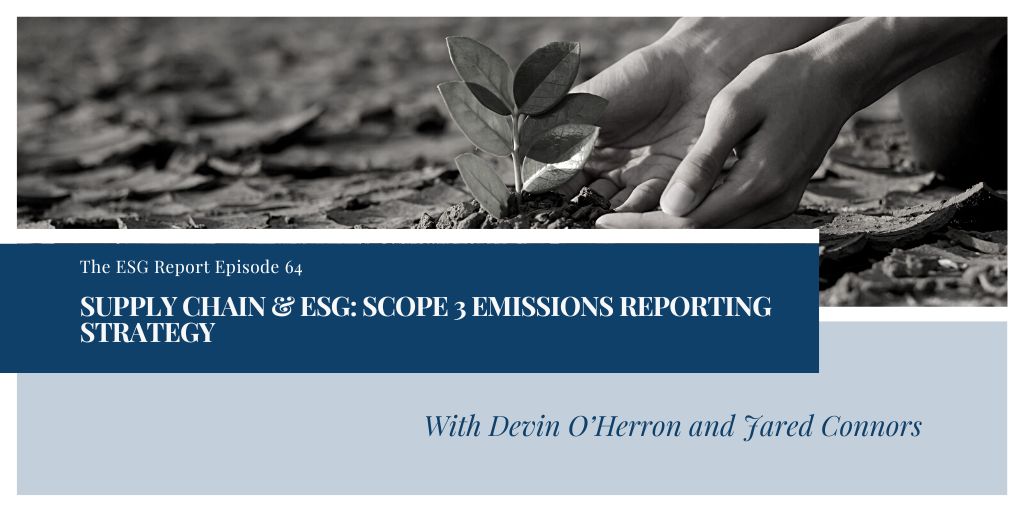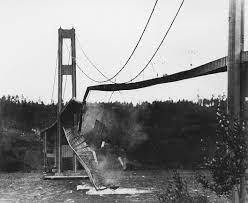I conclude my Great Structures Week with a focus on structural engineering failures: suspension bridges and the challenges of wind in their construction and maintenance. I am drawing these posts from The Great Courses offering, entitled “Understanding the World’s Greatest Structures: Science and Innovation from Antiquity to Modernity”, taught by Professor Stephen Ressler. In his chapter on suspension bridges he notes that the “Tacoma Narrows Bridge was the third longest span in the world when it opened to the world, this month of July in 1940.” Yet it collapsed only four months later, in one of the most famous visual images of a bridge’s collapsing. This is due to the “inherent flexibility of cable as a structural form”. A bridge can move in longitudinal vibration, that is up and down and in torsion, where it twists from side-to-side.
Most people recognize unstiffened suspension bridges as old as man and engineering itself. It was not until the 1820s that serious study was brought to bear on the issue of wind-related collapse of suspension bridges. The initial solution was to simply use more weight to reinforce the span. However, while that solution did bring some stability, it reinforced damage as the structure became a textbook example of Newton’s Second Law of Motion, which states that the acceleration of an object is dependent upon two variables – the net force acting upon the object and the mass of the object; meaning that once a heavy weight is in motion, it is more resistant to deceleration.
Yet it was scientific methodology that led to the disaster with the Tacoma Narrows Bridge. An engineer named Leon Moisseiff had developed a theory that long spanned suspension bridges were heavy enough that they did not require stiffening trusses because “their mass stabilized them against wind-induced vibrations.” However, this theory failed to take into account how air flows around a bridge and the “dynamic response of the structural system.” Ressler concludes this section by stating, “this case has become a classic symbol of the dangers of arrogance born of overconfidence in science-based design methods, and belt-and-suspenders engineering has made a bit of a comeback.”
I thought about the catastrophic failure of the Tacoma Narrows Bridge in the context of one of the greatest risks in Foreign Corrupt Practices Act (FCPA) compliance; that being third parties. Many non-compliance corporate employees assume that if a third party passes due diligence muster; they are in the clear. After all, you cannot stop a third party from making a bribe or other corrupt payment. Fortunately, the Department of Justice (DOJ) does not take such a myopic view as many business types. Under the FCPA, a company is responsible for the actions of its third-party representatives.
The real work around your third-party compliance program begins after the contract is signed and it is in the management of the third-party relationship. While the FCPA Guidance itself only provides that “companies should undertake some form of ongoing monitoring of third-party relationships”. Diana Lutz, in “Global anti-corruption and anti-bribery program best practices”, said, “As an additional means of prevention and detection of wrongdoing, an experienced compliance and audit team must be actively engaged in home office and field activities to ensure that financial controls and policy provisions are routinely complied with and that remedial measures for violations or gaps are tracked, implemented and rechecked.”
Carol Switzer, writing in the Compliance Week magazine, set out a five-step process for managing corruption risks, which I have adapted for third parties.
- Screen – Monitor third party records against trusted data sources for red flags.
- Identify – Establish helplines and other open channels for reporting of issues and asking compliance related questions by third parties.
- Investigate – Use appropriately qualified investigative teams to obtain and assess information about suspected violations.
- Analyze – Evaluate data to determine “concerns and potential problems” by using data analytics, tools and reporting.
- Audit – Finally, your company should have regular internal audit reviews and inspections of the third party’s anti-corruption program; including testing and assessment of internal controls to determine if enhancement or modification is necessary.
Additionally, there several different functions in a company that play a role in the ongoing monitoring of the third party. While there is overlap, I believe that each role fulfills a critical function in any best practices compliance program.
Relationship Manager
There should be a Relationship Manager for every third party which your company does business. The Relationship Manager should be a business unit employee who is responsible for monitoring, maintaining and continuously evaluating the relationship between your company and the third party.
Compliance Professional
Just as a company needs a subject matter expert (SME) in anti-bribery compliance to be able to work with the business folks and answer the usual questions that come up in the day-to-day routine of doing business internationally, third parties also need such access. A third party may not be large enough to have its own compliance staff so I advocate a company providing such a dedicated resource to third parties. This role can also include anti-corruption training for the third party, either through onsite or remote mechanisms. The compliance practitioner should work closely with the relationship manager to provide advice, training and communications to the third party.
3rd Party Oversight Committee
A company can have a Third-Party Oversight Committee review documents relating to the full panoply of a third party’s relationship with the company. It can be a formal structure or some other type of group, but the key is to have the senior management put a ‘second set of eyes’ on any third parties who might represent a company in the sales side. In addition to the basic concept of process validation of your management of third parties, as third parties are recognized as the highest risk in FCPA or Bribery Act compliance, this is a manner to deliver additional management of that risk.
After the commercial relationship has begun the Third-Party Oversight Committee should monitor the third-party relationship on no less than an annual basis. This annual audit should include a review of remedial due diligence investigations and evaluation of any new or supplement risk associated with any negative information discovered from a review of financial audit reports on the third party. The Third-Party Oversight Committee should review any reports of any material breach of contract including any breach of the requirements of the Company Code of Ethics and Compliance. In addition to the above remedial review, the Third-Party Oversight Committee should review all payments requested by the third party to assure such payment is within the company guidelines and is warranted by the contractual relationship with the third party. Lastly, the Third-Party Oversight Committee should review any request to provide the third party any type of non-monetary compensation and, as appropriate, approve such requests.
Audit
A key tool in managing the relationship with a third-party post-contract is auditing the relationship. I hope that you will have secured audit rights, as that is an important clause in any compliance terms and conditions. Your audit should be a systematic, independent and documented process for obtaining evidence and evaluating it objectively to determine the extent to which your compliance terms and conditions are followed.
Perhaps now you will understand why I say that managing the relationship of your third party’s is where the real work of your FCPA compliance program comes to the fore. It also demonstrates a key difference in having a paper compliance program and doing compliance. Having a paper compliance program is simple but doing compliance is not always easy; you have to work at it to maintain an effective program.
I hope that you have enjoyed this week’s offering based around some of the world’s greatest structures, their engineering concepts and innovations and how they all related to a best practices compliance program. I am a huge fan of The Great Courses offerings and if you are interested in learning in a great many areas it is one of the best resources available to you.








